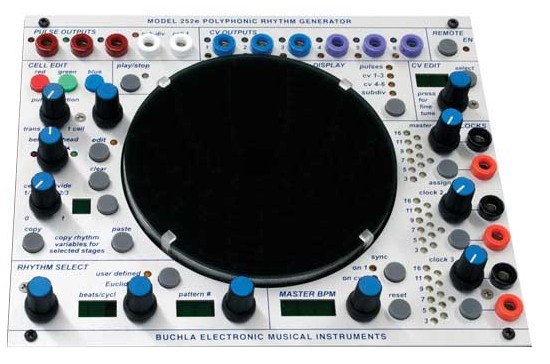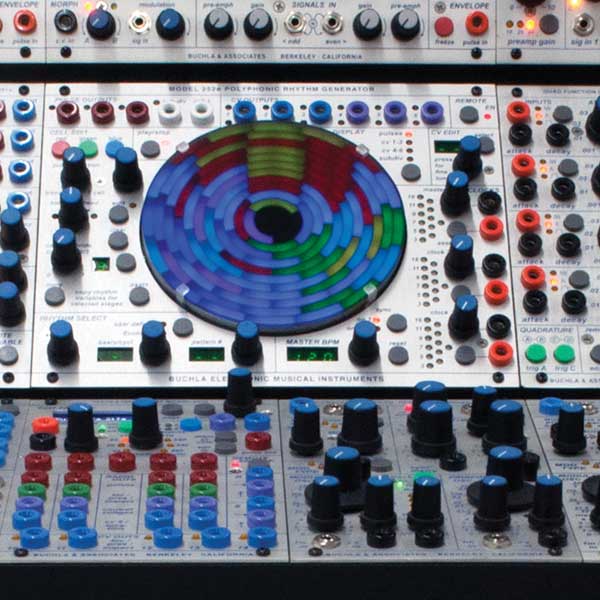
At the 2015 NAMM Show, Buchla Electronic Musical Instruments introduced the 252e Buchla Polyphonic Rhythm Generator.
The 252e Buchla Polyphonic Rhythm Generator is a high-end polyphonic, polyrhthmic, polymetric step sequencer.

The interface features 11 concentric rings, each with their own ability to generate complex patterns. The rings vary in number of steps from 3 to 16. Three sequences can run, on any of the rings.
Sequences on different rings can be synced in several ways. They can be synced by the unit of the sequence, so a sequence with 3 steps would repeat twice in the time it takes for a 6-step sequence.
Sequences on different rings can be synced so that their cycles align. This lets you create sequences where 5 notes play in the same time as 7 notes in another sequence, for example.
Sequences can also be free-running, with different BPMs.
The Polyphonic Rhythm Generator also includes a built-in Euclidian rhythmic library. Sequences of any length can use Euclidian rhythms of any note density. The start point of the Euclidian rhythms can also be shifted forward or back in relation to other patterns.
Three clocks drive the rings, which are freely assignable to 4 pulse and 2 CV outputs, allowing an amazing amount of flexibility to shift, cross-trigger and explore totally new musical possibilities. A rich MIDI implementation compliments the user interface that invites experimentation.
The 252e Buchla Polyphonic Rhythm Generator is priced at $2,499. See the Buchla site for more info.

A more complicated way to sequence, and for an insane amount of cash! Good grief.
For that kind of money I’ll stick with a used Moog Voyager and a software sequencer
The good news is, BEMI is developing new modules that employ new ideas. The utility of those concentric rings as a user interface remains to be determined — is that a touch surface or just a display?
It is only a display.
The idea is to get away from the limitations of the usual row of 16 slots traditionally found on most hardware sequencers. When you work with shifting patterns like say 5 against 4, they re-align after 20 slots. On a linear setup you cannot see the whole pattern at once (unless you switch to 32th notes but you’ll need two patterns to reach 20). With a circular display, patterns can graphically shift away for ever.
It seems to be essentially multiple trigger sequencers with seperate divisions. Pretty easy to do this with other modular already. I’ll keep my money!
Yes indeed. I already do this with the Trigger Riot all the time.
Yes, I see a lot of functional similarities to my trigger riot.
i have been waiting for this for a few years
but ,,
i will have to settle with REAKTOR’s Spiral Sequencer and a beatstep pro
until i can get buchla monies (o_0)
same knobs on my quasimidi 309…..I’m rich !!!!
absolutely beautiful
absolutely unattainable
I love the looks of Buchla gear, like something you’d see on the bridge of the Enterprise.
If money was no object, this is a good idea…
It has turned into big bucksla. No thanks.
Amazing IDEA! I need more of them!
Even if you can not afford a Buchla it needs innovative heads with visions like them!
This how it works everywhere, no H&M without J P Gaultier, no Audi R8 without Formula 1
Looks amazing but I think the Koma Komplex is better & a little more resonable regarding price. Seriously wouldn’t mind a Komplex seq, perfect for my needs & something I’ve been dreaming about for a while. Time to save the penny’s still!!
But you do get 2499 Buchla points if you buy one…
10 years from now, I hope this is possible for 1/10th of the price
The 252e is a very “deep” module, there is much more to it than a circular step sequencer. Traditional sequencers tend to operate with an assumed concept of a “note”, a grouped unit of time/pitch (and maybe velocity). It’s not obvious from the public information about the 252 that there is no inherent relationship between pulses and the 6 CV outputs. Cells can have pulses but no CVs, or CVs but no pulses. The pulses (i.e. rhythmic patterns) can be rotated/shifted independently of CVs and therefore pitch or velocity. Pitch and velocity information can be captured into rings in real time via MIDI. The 252e is more of a rhythmic performance instrument/laboratory than a “round step sequencer”. It is admittedly expensive, in keeping with other Buchla gear. However it is also very deep, flexible, and conceptually unique as far as I know.